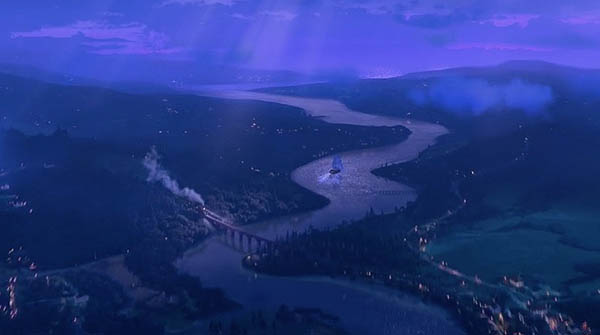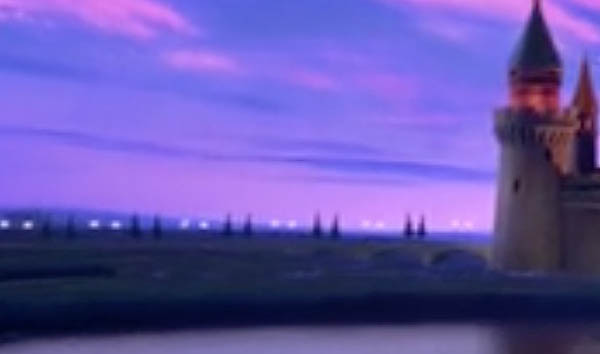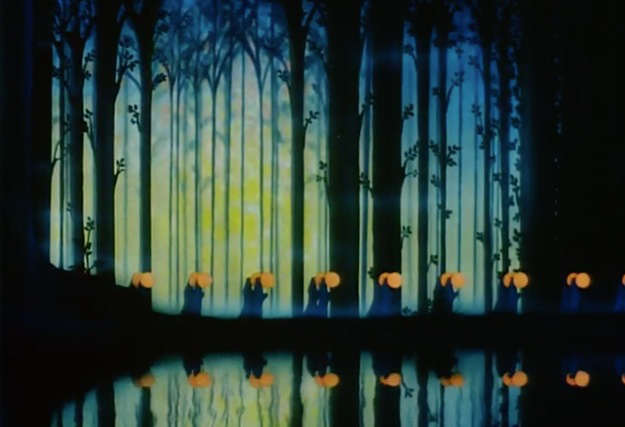Have you ever been here? I mean lately.



Saw “Frozen” with daughter, because Disney animation premiers are now equal to Pixar premiers. They have a secret weapon, too: whereas Pixar movies begin with Luxo bouncing across the screen to jump on the I, Disney animation opens with two sequences that have much deeper resonance: the gorgeous pull-back that shows not just the castle, but the river with the ship (Captain Hook at the wheel, not Jack Sparrow, depending on your generation) and the long bridge with the lights that recall the end of Fantasia.




When you wish upon a star goes right to the elemental childhood memories, or the memories you have with your own children, and everything is sewn up and gift-wrapped and pixie-dust-sprinkled before the movie starts.
Then the sequence for Walt Disney Animation, which uses “Steamboat Willie.” This is the lineage. This is what looms over it all. We hope not to shame the name. The short that came before “Frozen” is an interesting lesson in Disney vs. Pixar - an internecine rivalry that can only make each studio better. Pixar pushed the definition of animation with the “Umbrella” short before the last release; Disney went way back to rubber hose animation and Pegleg Pete and Minnie in peril, but literally broke the Fourth Wall. I goggled at the Pixar pre-show short, and was impressed more than I was moved; the Disney short had less technical innovation and more imagination within the strict definitions of the Mickey Cartoon Concept, and made me laugh.
I rarely laughed at an old silent Mickey. You admire, study, note, place the innovations in context, chalk up a gag for future reference, enjoy - but laugh? Out loud? I don’t think I’ve ever laughed at Mickey, anymore than you remember laughing at an old friend. This is why Goofy was necessary, and Donald. You laughed at them, at their expense. This short was the same: Horace Horsecollar and Pegleg provided the physical comedy, Mickey provided the ingenuity, and they went back and forth between the 2D black-and-white world and the 3D world of the audience. And it was funny. Pitchfork gags, for heaven’s sake. Jabbed in the arse. A rung-busting trip down the ladder chin first.
One moment I suspect may have occasioned some memos: Mickey pierces the screen, ends up on the stage in the Real World, three-dimensional, colored. He looks down: “Oh! Red!” Which means this is Mickey before color. If that’s the case, why didn’t he do any of these things ever again? It doesn’t matter. Mickey gets to reset to zero any time they wanty. Mickey is a tabula rosa.
By the way, here's the first minute:
<iframe width="600" height="338" src="//www.youtube.com/embed/OOX2Y9qic-A" frameborder="0" allowfullscreen></iframe>
The voice is Walt Disney. Says Time:
"When Mickey goes modern and sees that his pants, once black-and-white, are red, his exclamation is really a mash-up of the sounds rrr and ed. “That one word took maybe a week and a half,” says MacMullan."
Read more: 'Frozen' Short 'Get a Horse': Walt Disney's Voice | TIME.com http://entertainment.time.com/2013/11/25/walt-disneys-cryogenically-frozen-voice-resurrected-for-new-frozen-cartoon/#ixzz2mGtxDKWP
Anyway, “Frozen.” I wasn’t crazy about the character design of the snowman, amusing as he was, or the Snow Monster Thing towards the end. The songs weren’t as good as “Tangled.” That said: spectacular when it needed to be, affecting, funny, and surprising. We loved it. The first half-hour banks a huge deposit of goodwill the rest of the film spends with well-budgeted skill; everything is established with efficiency, but there’s so much heart and beauty in every frame you're sunk deep in the story, with revelations and twist and tunes tumbling at you. Joy! Oh no tragedy. Salvation! Oh no pathos. Happiness! Oh no sororal emotion.
The end, the drama, the moment, the climax: and then it was that, which you didn’t expect - and then the happy bustling summertime restoration of the Order of Things with a twist, ta da, THE END, and the entire theater burst out in applause.
We sat through the credits to read all the names, a thing I like to impress upon Daughter: there may be a treat at the end of it, and let us look at all the people who made this thing for us. When the credits ended we were alone in the theater, except for the cleaning staff moving from the top aisle down like Langoliers. We talked about it down the hallway. We talked about it through the lobby. We talked about it through the mall, discussing what we didn’t see coming and what we thought was going to happen, and I’m sure the producers and writers would have clapped their hands and mopped their brows in relief: exactly, EXACTLY.
It’s our thing. I love how they started it out with the most Classically Classic Mickey, which goes back to all the cartoons I made her watch, then gave us another Princess, as if to say “yes. We are Disney. Princesses. Deal with it, okay? Here: find fault with this one. Good luck.” And daughter takes away something other than Cinderella, and Dad’s happy the Hero is a grand role model for the Manly Arts of Work, Honor, Devotion, and Burly Affinity with family and a co-worker.
Hours later I went to Daughter’s room to see what she was up to, and she admitted me a brief glance of the drawing she’d done of one of the movie’s heroines. It wasn’t the one I expected.
You think you know, but then you don’t.

I've heard about this one. Not being a Bette Davis fan - oh, I know, horrors. It's not that I don't like her; she's just not a reason I have to see a film. But hey, SATAN!



It begins with this:



1936? Possibly that's the California Pacific International Exposition. which ran from 1935 to '36. It gets lost between the Chicago and New York versions.
Our hero is the cheerful and urbane William Warren - er, Warren William. He could also be cruel and amoral. He was also Perry Mason, and was all wrong for the role. He's a private eye here, and in the 30s mold, he's a cheerful dapper wisecracking type. Name: Ted Shane.



He has a partner. One day a dame walks in and says she needs protection. She's being followed. She's terribly worried. They don't believe her, completely, but her money's good.



The partner goes to work on it, and ends up . . . dead! In a fog-shrouded graveyard, no less.


Hmm.
Hmmmmm. Anyway, Shane calls his secretary, gets her out of bed: she lives in one of those monochromantic swamk joints usually reserved for gang molls.



She has to tell Shane's partner's wife that her husband is dead. The wife turns up the next day in the office, tearful - turns out she's been carrying on with Shane.
Uh . . .
Sorry; deja view, or whatever it's called. Anyway, the shamus has to go avenge his partner, and finds out that Bette Davis' story wasn't legit. She's looking for something else - and so are some other people. There's one character who keeps following Shane around:



Shane delights in ribbing him and making fun of him, which just makes the guy even more mad.
Well, Arthur Treacher shows up.



He explains really what's going on, and enlists Shane to find something. Bette Davis is looking for it. So is the Fat Woman. Yes, the cherubic thug brings Shane to her house, where she offers a drink. She likes a man who likes to have a drink. She admires a man who speaks frankly about enjoying a drink. Yes sir. Yes she does.



She's looking for something as well. They're all looking for it. The legendary Horn of Roland, an antique filled with jewels. A sailor delivers it, and all the characters are licking their chops with greed. After all these years of chasing the Horn around the world, they've found it!



Unfortunately, it's a fake. The cops come and arrest everyone. Of course, you know who shot the partner: Bette Davis. "Satan Met a Lady" was a remake of a movie made a few years before. They took another run at it a few years later.
Third time was the charm.



And you think remakes are a modern invention! Well, see you around; work blog and tumblr today. Matches below. See you around.
|

